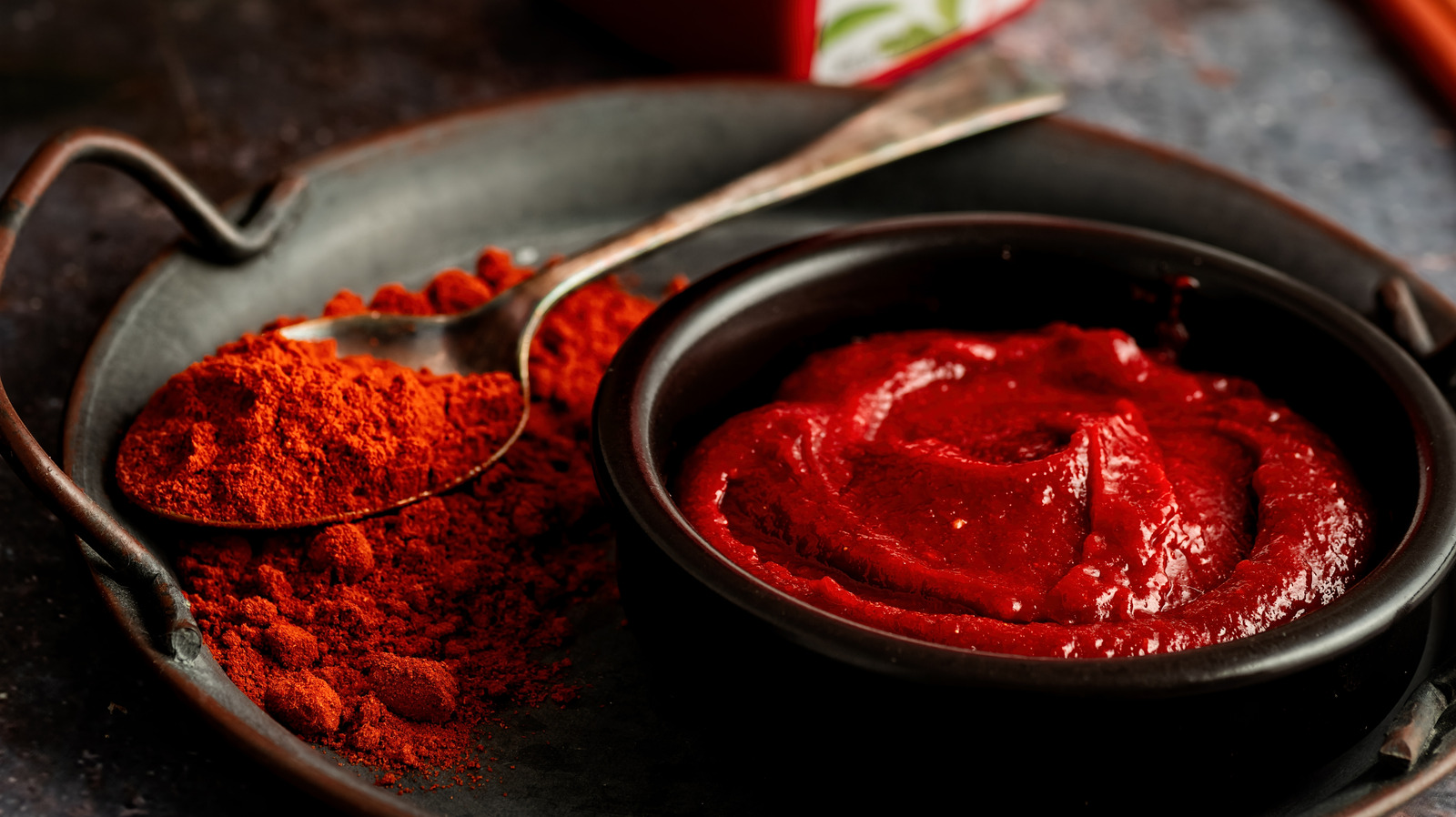We may receive a commission on purchases made from links.
If you find yourself dining in a Korean restaurant in the near future, one of the many blessings of the evening comes to the table looking like a thick red paste you might put slather on a canvas with a palette knife to create a visual art masterpiece. It’s gochujang paste, and while it is a masterpiece, it’s a work of art of the culinary sort, not the fine art kind. No matter. Its thick, brick-red texture lends an amazing mouthfeel and a spicy and sweet umami-rich flavor to everything it touches. On top of eggs. Stirred up in stews. Slathered on the assorted cuts of meats at a Korean BBQ.
In other words, it’s ubiquitous, and it ought to be. It’s been around long enough — several hundred years, at least — giving it enough time to be something that can be found from one end of the globe to the other. But while it’s everywhere, not everyone has tried it. If you’re among them, this is a serious foodie mistake you’ll want to correct and soon. Because its flavor is a unicorn among condiment flavors, it’s something that’s difficult to replicate and even more difficult to forget once you’ve tried it. In other words, it’s just the seasoning you need to make all your great Asian dishes taste even better.
What is gochujang paste?
Like Worcestershire sauce, gochujang paste is a seasoning (or condiment, depending on who you ask) that has many uses and just about as many ingredients. In the simplest terms, it’s a fermented Korean chili paste. But it isn’t just chilies, vinegar, and maybe some chili oil like some Asian chili pastes are. Certainly, it does contain hot chilies, but its ingredients list also boasts rice, fermented soybeans, soy sauce, salts, and yeast extracts.
Individual recipes for gochujang do vary, but a few flavors (usually the fermented ones) stand out in every gochujang recipe. It has been likened to miso because of the fermentation, and some recipes for gochujang paste actually call for miso paste. Overall, because of its myriad ingredients, it introduces a mix of flavors onto the tongue simultaneously, including sweet, hot, salty, and umami, making it one of the most complex flavorings around the culinary scene.
What are the origins of its ingredients?
Because gochujang paste is a blend of ingredients, the origins of those ingredients are also mixed. Let’s start with the chilis that give the gochujang such a kick. Although the fermented chili flavor is associated with Korean cooking, that flavor doesn’t come from Asia. Chilies are actually native to the Americas. Due to international trade in the 1400s, chilies eventually made their way to India, Asia, and Africa, eventually setting the stage for the chili paste recipes, including gochujang, to follow.
As for glutinous rice in the paste, the cultivation of the grain goes back at least 5,000 years. Historians believe that it originated in either Thailand, China, or India. However, its exact birthplace is unknown. In most recipes for gochujang, the rice becomes glutinous rice flour. It earned this name not because of any gluten content but due to its sticky consistency.
As for the soybeans that make up the soy sauce and red miso that adds the fermented flavor to the condiment, they found their origins in Southeast Asia, where farmers began cultivating them by 1100 B.C. Finally, some recipes for the seasoning also call for some sort of sweetener, whether it be honey, sugar, corn syrup, or something else. As such, the origins of those ingredients will vary, depending upon which sweetener the chef uses to create the condiment.
How is gochujang made?
Because gochujang is a fermented product, it takes quite a bit of time to make it, anywhere from four to six months. The process begins with barley malt being soaked for several hours, which turns the concoction into liquid malt wort. (If you think this sounds like the malted barley in beer, you’d be correct.) The barley malt substance contains the important amylase enzymes that permit the fermentation process to move forward. More specifically, it extracts the natural sugars from the glutinous rice. This is one of the reasons why gochujang tastes sweet even if additional sugars aren’t added to it.
The malt water that’s left at the end of the straining process gets combined with rice powder and is then heated up. Salt, fermented soybeans, and finally, an infusion of gochugaru (which is finely-ground chili powder) make up the last ingredients in the gochujang paste. The last step is fermentation.
Finally, as with most traditional recipes, the ingredients for gochujang can vary, depending on who’s making it. Home gourmands have been known to include ingredients like honey and red miso paste, which offer additional ways to create a sweet, fermented end-product. Other variations include extra gochugaru (chili powder) to make it spicier.
Gochujang Vs. Thai chili paste or sriracha
One of the things that fans of gochujang paste love so much is how distinct the taste is due to the rich fermented umami flavor. As such, it can be difficult to find a substitute to use in recipes if you run out of it. That said, some gochujang paste substitutes work better than others, and each is worth a try for different reasons.
One popular substitute is sriracha. Taking it from a tasty Thai condiment to almost gochujang-like requires the addition of sugar or another kind of sweetener because while sriracha boasts the spicy heat of gochujang, it lacks its sweetness.
For people who are fans of gochujang’s mouthful and texture, Thai chili paste is another thing that foodies turn to once the gochujang pale has been scraped dry. A sometimes heavy garlic flavor is what really sets Thai chili paste apart from gochujang, however. Use it if your recipe is more dependent on the texture of gochujang instead of the fermented flavor.
Finally, you can always doctor up Chinese hoisin sauce with a bit of chili powder or flakes if you need something that resembles gochujang. Like the Korean chili paste, hoisin boasts fermented ingredients — in this case, fermented soybeans. This, coupled with its sugar content, makes it one of the better options when it’s time to find a substitute for your favorite gochujang.
What does gochujang taste like?
Gochujang isn’t a one-trick pony when it comes to flavor. That’s why it’s such a popular addition to Korean cuisine and why it’s so hard to replicate when you’re out of it. It’s pungent, with sweet, spicy overtones and hints of salty umami. More simply, it’s like a mashup of miso paste and sriracha or Thai chili paste, with a bit of honey or sugar mixed in for good measure.
You can also taste a hint of smokiness in gochujang paste. It’s no wonder, then, that it is a go-to ingredient when it’s time for some Korean barbecue. In fact, this ingredient often hides in barbecue sauces and marinades, whether the food being marinated is labeled Korean cuisine or not.
How to cook with gochujang
It’s probably fair to say that if you’ve experienced Korean cooking, then you’ve also experienced gochujang. Cooks of Korean cuisine put it into practically everything. A prime example is bibimbap, which is a classic Korean rice bowl. An explosion of ingredients like fresh vegetables, savory meats, and a fried egg get flavored up thanks to gochujang paste. It also works as a base for sauces for Korean barbecue. And hot wings? Forget that traditional Buffalo hot wings recipe and try it with gochujang instead. The hot and savory umami kick is just what your party needs.
Salad dressings get a kick, too, when you add this spicy seasoning to the mix. Ginger and lime in a salad dressing cool down the effects of gochujang without taking away any of its pungent flavor, making for a more interesting and palate-cleansing choice on a bed of fresh greens. And speaking of cleansing the palate, that great palate cleanser, kimchi, sometimes calls for gochujang, depending on the recipe you’re using.
While Korean dishes seem to have a monopoly on gochujang usage, many savvy home gourmands have blown past using it in traditional Asian dishes and have started adding it to all sorts of recipes. It flavors kale crisps, funky chili recipes, or a spicy fettuccine Alfredo. In the latter case, habanero peppers are often used, but you don’t have to stick to that rule when you want to give your Alfredo a spicy kick . Experimentation in cooking often turns up pleasant surprises, and this combo — gochujang paste and Alfredo sauce — might just be one of them.
Where to buy gochujang
Given that gochujang is a staple of Korean cuisine, you might be tempted to think that the best place to start looking for it is at the local Asian supermarket, and while you’ll definitely hit the jackpot there, that’s not the only place that carries this condiment/ seasoning. In grocery stores like Walmart, Trader Joe’s, and Albertson’s, you’ll sometimes find it in the Asian aisle or in the refrigerator aisle.
Online retailers like Costco and Amazon carry it as well. This might be the place to look if you need a vegan brand of gochujang, like SEMPIO Vegan Gochujang. Other good brands to try include Bibigo, Mother in Law’s, and One Culture. Prices vary, depending on the brand, but generally speaking, it’ll set you back between $4 and $10 when you purchase it at the local Big Box grocery store.
Nutritional info about gochujang
Like many foods that fall into the condiment category, gochujang has its share of sugar and sodium, coming in at 24% and 108%, respectively. Chalk that up to ingredients that are meant to make it and the foods it’s used on taste good.
But its ingredient breakdown goes beyond just the sugar and salt content. Gochujang possess some things that make it worthy of a second look from a nutritional standpoint, boasting five grams of fiber and five grams of protein. Other nutrients include vitamin C, vitamin A, and iron.
Finally, the chilies in gochujang contain capsaicin, which is a bioactive compound found in the peppers. Carotenoids and flavonoids are the other bioactive compounds in gochujang. All of these compounds introduce antioxidants into the seasoning, making it something that’s worth a second bite.
Varieties of gochujang paste
A look back in culinary history tells us that gochujang paste has existed since the 16th or 17th century. As such, home gourmands and pro chefs alike have had a lot of time to play around with the recipe. In the process, they create the variations of gochujang we see today. On the most basic level, the condiment consists of gochugaru, fermented soybean powder, glutinous rice, and salt.
It’s what gets added to each individual recipe that accounts for the variations. You can find it gluten-free or infused with vinegar. It’s additionally possible to find versions of it that are extra hot or somewhat mild and even something in between. The heat levels in the condiment are dependent on how much chili powder is used in the product. If you’re not a big fan of big heat (or conversely, if you are), pay attention to the label to ensure that you get the right amount of spice in your spicy chili paste. Usually, you’ll find the containers of the condiment’s container labeled with mild, medium, or spicy designations. This labeling system is your clue to how spicy the condiment in the jar is or isn’t.
How to store gochujang
When it comes to caring for gochujang after it’s opened, the following phase offers good advice: When in doubt, don’t leave it out. While you might make it a practice to store mustard (and other condiments) at room temperature, it’s best not to go this route with gochujang. Instead, it needs to be in a container with a lid to prevent it from drying out or changing color. If you use it frequently, wrap it up with a layer or two of cling wrap to give yourself extra insurance against cracking and crumbling.
Fortunately, it’s usually sold that way in the store — in a sealed container with a lid – but the rule applies to homemade gochujang as well. Provided that you store it correctly, it’ll last about as long as a container of miso will — six months to a year or more. If you open it and it’s watery, smells bad, looks moldy, or its color is slightly off, don’t eat anymore of it. It’s gone bad. Time to toss it out.





